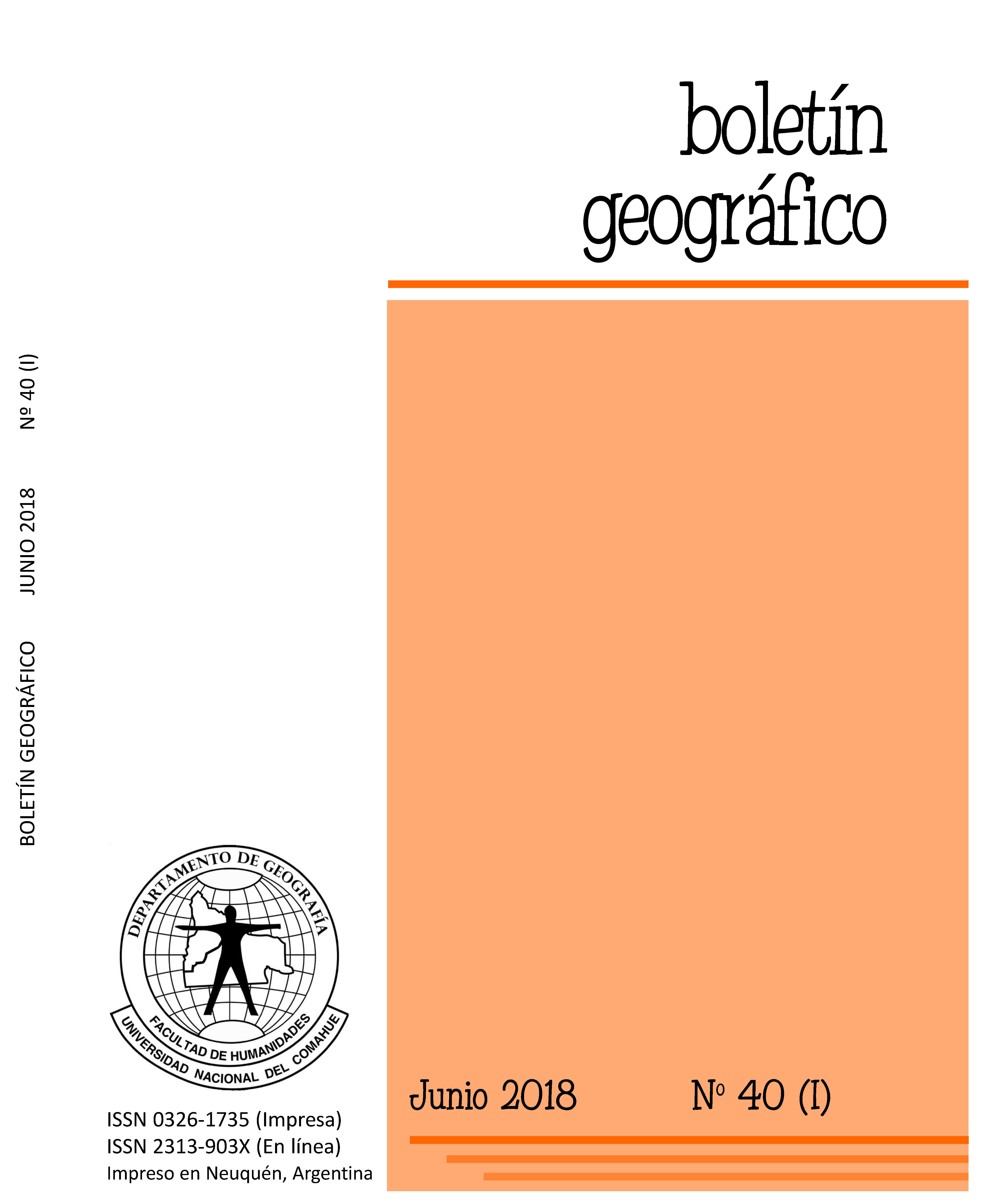MORPHOMETRIC OF THE COLORADO RIVER HIGH BASIN, ARGENTINA
Keywords:
Grande River, Barrancas River, SRTMAbstract
The Grande and Barrancas Rivers watersheds conform the upper basin of the Colorado River. They provide discharge from snow precipitated in the high mountain peaks. Morphometric and functional characteristics analysis of a basin is elementary in hydrology and modeling approach. The aim of this work was to analyze and interpret the morphometric parameters and derived indices of the upper basin of the Colorado River, Argentina. Parameters quantification and analysis were based on a digital elevation model and Geographic Information Systems. Length of the Grande River is three times greater than Barrancas River ones, with a drainage area that follows the same relationship. Gravelius coefficients evidenced similarities in watershed shapes, both rectangled-oblongued. Both watersheds have a half of their area between 1500 and 2500 m.a.s.l., with predominant slopes between 0 and 15o. In both cases, 54% of slopes are orientated to south direction, meaning predominantly shady. Barrancas River has a greater difference between the source and the mouth, having a smaller drained area. Results from this study offers an important source of base information to further research and modeling spatio-temporal dynamics of flow of River basin.
Downloads
References
Ardiansyah Prima, O.D.; Echigo, A.; Yokoyama, R. & Yoshida, T. (2006). Supervised landform classification of Northeast Honshu from DEM-derived thematic maps. Geomorphology, 78, 373-386.
Bayona Celis, A.; Rivera Sánchez, E.; Valtierra, J.G.; Martínez Reséndiz, W.E. & Montoya Martínez, A. (2006). Caracterización de los ecosistemas, cambios en el uso del suelo y unidades paisajísticas en la reserva de la biósfera “Sierra Gorda” de Querétaro. Reporte Técnico, Tomo XII, Llata Gómez, R. coord., Consejo de Ciencia y Tecnología del Estado de Querétaro, México.
Bolongaro-Crevenna, A.; Torres-Rodríguez, V.; Sorani, V.; Frame, D. Y Ortiz, M.A. (2005). Geomorphometric analysis for characterizing landforms in Morelos State, Mexico. Geomorphology, 67, 407-422.
Boninsegna, J.; Llop, A. (2015). Impactos y vulnerabilidad al cambio climático de los principales ríos de Mendoza y San Juan a partir de la evolución de los glaciares cordilleranos. La economía del cambio climático en la Argentina. Santiago de Chile, CEPAL - Serie Medio Ambiente y Desarrollo N° 161., pp. 1-67.
Busnelli, J; Horta, L. R. (2014). Morfometría de cuencas montañas y metamorfosis fluvial, Tucumán. Revista de la Asociación Geológica Argentina. 71 (1): 11-20.
Castillo, E. B.; Chichiple, M. E. & Salas López, R. (2017). Comparación de los MDE
ASTER Y SRTM en el análisis morfométrico de la cuenca del Utcubamba (Perú).
Indes, 3, 86-98.
Clennon, J.A.; Kamanga, A.; Musapa, M; Shiff, C. & Glass, G.E. (2010). Identifying malaria vector breeding habitats with remote sensing data and terrain-based landscape indices in Zambia. International Journal of Health Geographics, 9, 1-13.
COIRCO (Comité Interjurisdiccional del Río Colorado). (2014). Programa Integral de Calidad de Aguas del Río Colorado – Calidad del Medio Acuático. Informe Técnico. Comité Interjurisdiccional del Río Colorado, Secretaría de Energía de la Nación, Grupo Interempresario. (Consulta: 10-02-2016). www.coirco.com.ar
Cuomo, A. & Guida, D. (2010). Orographic barriers GIS-based definition of the Campania-Lucanian Apennine Range (Southern Italy), poster session Complex System in Geomorphology, Geophysical Research Abstracts, 12, EGU General Assembly, Vienna. http://meetingorganizer.copernicus.org/EGU2010/EGU2010-
Daniele, C. L. & Natenzon, C. E. (1994). Las regiones naturales de la Argentina: caracterización y diagnóstico. En: El Sistema Nacional de Areas Naturales Protegidas de la Argentina. Diagnóstico de su patrimonio natural y su desarrollo institucional. Buenos Aires, APN; pp 1-34
Drăguţ, L. & Blaschke, T. (2006). Automated classification of landform elements using object-based image analysis. Geomorphology, 81, 330-344.
Farr, T. G.; Rosen, P. A.; Caro, E.; Crippen, R.; Duren, R.; Hensley, S.; Kobrick, M.; Paller, M.; Rodriguez, E.; Roth, L.; Seal, D.; Shaffer, S.; Shimada, J.; Umland, J.; Werner, M.; Oskin, M.; Burbank, D. & Alsdorf, D. (2007): “The Shuttle Radar Topography Mission”, Geophysics, 45, 21- 22.
Felicísimo, A. (1994) Modelos Digitales de Terreno. Introducción y aplicación en las ciencias ambientales. http://www6.uniovi.es/~feli/pdf/libromdt.pdf
Gaspari, F. J.; Senisterra, G. E.; Delgado, M. I.; Rodríguez Vagaría, A. & Besteiro, S. (2010). Manual de Manejo Integral de Cuencas Hidrográficas. Ed. Gaspari. La Plata, Argentina, pp. 321.
Gaspari, F. J.; Vagaría, A. M. R.; Senisterra, G. E.; Denegri, G.; Delgado, M. I. & Besteiro, S. (2012). Caracterización morfométrica de la cuenca alta del río Sauce Grande, Buenos Aires, Argentina. Revista Electrónica del Comité del Medio Ambiente AUGM DOMUS, 4, 43–158.
Gaspari, F. J.; Rodríguez Vagaría, A. M.; Senisterra, G. E.; Delgado, M. I. & Besteiro, S. I. (2013). Elementos metodológicos para el manejo de cuencas hidrográficas. Universidad Nacional de La Plata-Editorial de la Universidad Nacional de La Plata, pp. 188.
Germaine, M. A.; Puissant, A.; Lespez, L.& Ballouche, A. (2006) Analyse spatiale et typologie des petites vallées bas-normandes, SAGEO’2006, Strasbourg, France, pp. 1-12.
Halcrow, (2013). Cuenca del río Colorado determinación de áreas de riesgo hídrico. Programa Multisectorial de preinversión III. Préstamo BID 1896/OC-AR. Comité Interjurisdiccional del río Colorado. Hidroestructuras S.A.
Lauro, C.; Vich, A. & Moreiras, S.M. (2016). Variabilidad del régimen fluvial en cuencas de la región de Cuyo. Asociación Argentina de Geofísicos y Geodestas. Geoacta 40 (2): 28-51.
Lascano, M. (2005). Análisis interanual de la estacionalidad de los ríos Andinos. Contribuciones Científicas. 17:185-200
Llamas J. (1993). Hidrología general: principios y aplicaciones. Servicio Editorial de la Universidad del País Vasco. España: 635 p.
Montoya Moreno, Y. & Montoya Moreno, B. (2009). Caracterización morfométrica de la microcuenca de la Quebrada de los Andes, El Carmen de Viboral, Antioquia- Colombia. Revista Ingenierías, 8 (15), 1-29.
Sánchez Serrano, F.; Tejero López, R. & Bergamín De La Vina, J.F. (1998). Análisis de la variabilidad del relieve a partir de modelos digitales del terreno. Revista Sociedad Geológica de España, 11, 139-149.
Schumm, S.A. (1956). The evolution of drainage systems and slopes in badlands at Pearth Amboy, New Jersey. Bulletin of the Geological Society of America, 67, 597- 646.
Senisterra, G. E., Rodríguez Vagaría, A. M., Gaspari, F. J. & Mazzucchelli, M. G. (2014). Aspectos morfométricos de la cuenca alta del arroyo Napaleofú, provincia de Buenos Aires-Argentina. Revista Geográfica Venezolana, 55(2), 287-303.
Sharma, A.; Tiwari, K. N. & Bhadoria, P. B. S. (2009). Measuring the Accuracy of Contour Interpolated Digital Elevation Models”, Journal of the Indian Society of Remote Sensing, 37, 139-146.
Subsecretaria de Planificación Territorial de la Inversión Pública y Comité Interjurisdiccioal del río Colorado. (2013). Diagnóstico integrado y escenarios de futuro de la región y la cuenca del río Colorado, pp. 238. scripts.minplan.gob.ar/octopus/archivos.php?file=2656
Strahler, A. (1952). Hypsometric (area-altitud) analysis of erosional topography. Bulletin of Geological Society of America, 63, 1117- 1142.
Strahler, A. N. (1964). Quantitative geomorphology of drainage basins and channel networks, section 4-2, in V.T. Chow (ed.) Handbook of Applied Hydrology, 4-39.
Tagil, S. & Jenness, J. (2008). GIS-based automated Landform classification and topographic, landcover and geologic attributes of landforms around the Yazoren Polje, Turkey. Journal of Applied Sciences, 8, 910-921.
Weiss, A. (2001). Topographic Position and Landforms Analysis. Poster presentation. ESRI User Conference San Diego, CA, USA. www.jennessent.com/downloads/tpi- poster-tnc_18x22.pdf
Wise, S. M. (2000). “Assessing the quality for hydrological applications of digital elevations models derived from contours”, Hydrological Processes, 14, 1909-1929.
Published
How to Cite
Issue
Section
License
Copyright (c) 2018 Boletin GeográficoTransfer of rights and data processing
The acceptance of an article for publication in the Journal Geographic Bulletin implies the cession of the rights of printing and reproduction, by any means and means, of the author in favor of the Department of Geography of the National University of Comahue, which will not reject any request reasonable for the authors to obtain permission to reproduce their contributions. The total or partial reproduction of the works published in the Geographic Bulletin must be done citing the origin, otherwise, the copyright is violated.
Likewise, it is understood that the concepts and opinions expressed in each work are the sole responsibility of the author, without being responsible or in solidarity, necessarily, neither the editorial staff nor the editorial staff.
It is the responsibility of the authors to be able to provide interested readers with copies of the raw data, procedure manuals, scores and, in general, relevant experimental material.
Likewise, the Management of the journal guarantees the appropriate treatment of personal data
COPYRIGHT TRANSFER FORM


















 Journal of the
Journal of the 